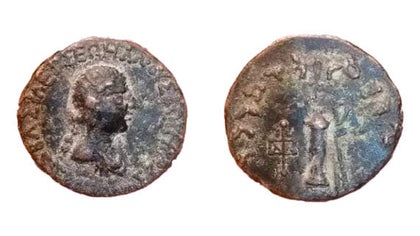Bronze Coin found in Pakistan

Detected with
OKM Rover UC (2011-2021)
Depth: 4.5 m (14.8 ft)
Region: Pakistan
Time of origin: 100 BC


This bronze coin was found in the summer of 2022 near the mighty Indus River in Pakistan by a treasure hunter using the OKM Rover UC. His discovery is more than a lucky find — it marks the emotional revival of a passion he had set aside for years.
Alongside a stone wheel and a fragile cauldron, the bronze coin appeared from 4.6 meters deep below the surface. Early research suggests it could be an ancient regional drachma — and previous finds in the area support this theory. Can you contribute more insights? Share your clues with OKM!
The finds were excavated at a depth of 15 ft (4.6 m) — a level only reachable with high-performance OKM 3D ground scanners like the Rover UC.
First Expeditions with the OKM Rover UC
After purchasing his Rover UC from an OKM dealer in Dubai back in 2013, the treasure hunter conducted his first expedition soon after. In a region rich with archaeological treasures — including a 10 g gold drachma and several unexplored historic sites — the Rover UC soon proved its potential.
The area was built as a fortification on a steep sliding slope — massive boulders weighing several tonnes were chiseled with astonishing precision, stacked like perfectly crafted bricks. We dug manually at two locations pointed out by the Rover UC, using shovels, chisels and stone picks.
One of their first finds was an ancient earthen cauldron located 2.4 meters deep. So fragile that even with utmost care, the treasure hunters could not recover it intact.

What Went Wrong?
Years later, the treasure hunter reflected on his early mistakes:
- We did not scan the rubble removed during digging.
- We assumed all treasures would be stored in containers — chests, pots or metal cauldrons.
- I misunderstood the 3D Ground Scan’s depth estimation on rocky terrain.
- We realized the construction stones came from elsewhere — perfectly cut blocks unlike the native rock.
- We never conducted control scans to rule out false alarms.
Despite multiple expeditions, work obligations eventually forced him to pause treasure hunting — until fate intervened.
Treasure Hunting Rediscovered After 7 Years
In 2022, a trove of coins was discovered near my ancestral home during land leveling. Hearing that news, something awakened — I remembered my Rover UC.
Driven by renewed excitement, he retrieved the detector, downloaded manuals and apps, replaced the batteries — and with OKM’s quick support, connected the device to his smartphone. In June and July 2022, he returned to the Indus region, historically known for Greek relics and Kushana-era finds.
Over two days, we uncovered a mud cauldron, a bronze coin and a perfectly rounded stone wheel — likely from an ancient flour mill.
The joy of finding something meaningful after years of silence was overwhelming. He proudly shared several scan images from his Rover UC with the OKM team.


The Quest for an Old Family Treasure
During one expedition, he uncovered a family story: his great-grandfather was rumored to have hidden a treasure beneath the family home.
I dug beneath my newly built house because of an old family saying — that my great-grandfather hid a treasure to protect it from his spendthrift son. No one knew the exact location…

The treasure hunter scanned the house and surroundings thoroughly. An intense red anomaly appeared in the scan — and OKM confirmed its potential. He dug down 15 ft (4.6 m), but found nothing. His family insisted he close the hole.
After closing the house project, we focused again on the mountain near the Indus — and found our first treasure: this bronze coin.
Our next expedition will be in December 2022 — we expect more major finds with the Rover UC.

To be continued ...
FAQ: Bronze Coin and Rover UC Discovery
What type of coin was discovered?
The bronze coin could be an ancient regional drachma, based on stylistic similarities with previous local finds from the Indus region.
How deep was the coin found?
At 15 ft (4.6 m), a depth achievable only with advanced 3D scanners like the OKM Rover UC.
What scripts appear on the coin?
The obverse shows Greek script, while the reverse uses Kharoshthi, indicating cross-cultural connections.
Why is the Indus region significant for treasure hunting?
It is historically rich — occupied by ancient civilizations, Greek-influenced cultures, and the Kushana Empire, resulting in diverse archaeological layers.
Why did early expeditions fail?
Incomplete scanning, misinterpretation of terrain, assumptions about containerized treasures, and lack of control scans contributed to missed opportunities.
How did the treasure hunter revive his passion after 7 years?
A newly discovered coin hoard near his ancestral home rekindled his interest — leading him back to his Rover UC and ultimately to this remarkable find.
What role did OKM support play?
OKM provided fast assistance with software and setup, enabling the treasure hunter to reconnect his detector and prepare for new expeditions.
Is more treasure expected in the region?
Yes — the landscape’s archaeological richness, combined with accurate scanning data, suggests further promising discoveries.
Get Rewarded for Your Treasure Finds
You have also made discoveries and detected amazing artifacts and would like to share them (anonymously)? We look forward to reading and publishing your success stories!


